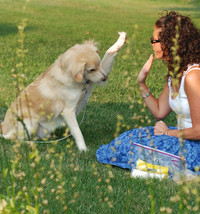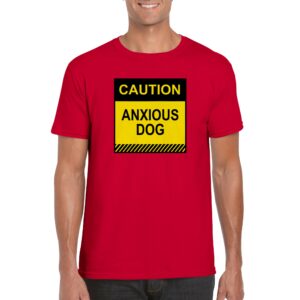Your cart is currently empty!
Sound reactivity, Aggression and paw preference

Updated Jan 27, 2025
Do you know what paw preference your dog has, if any? Some studies suggest (1) that female dogs might be more right-pawed on average, while males tend to be left-pawed, and some studies suggest preference might be flexible depending on the circumstances. (2)
However in one study, dogs without a significant paw preference were reported to be significantly more reactive to sounds (3) than dogs who were clearly left or right-pawed. One of the most common pathologies we see with hyper-reactive dogs is many of them react to noises. (4)
Other studies notes some correclation between left-pawed dogs having lower scores in stranger-directed aggression, while right-pawedness was significantly correlated with C-BARQ scores for the subscales of stranger-directed aggression, stranger-directed fear and attention-seeking behaviour. (5) However, in general, the conclusion of this study was that overall, this study provides little evidence in support of a relationship between paw preference and the occurrence of behaviour problems in the domestic dog.
Another study suggested that left-pawed animals being more negative or “pessimistic” in their cognitive outlook than right-pawed or ambilateral individuals. (6)
There is another advantage in knowing which paw preference your dog may have. Dogs that are left-pawed tend may pay more attention to the left side of things (visual and sound). This is reverse in right-pawed dogs and no bias in attention appears in ambidextrous dogs.(7)
Note that one study indicated that even though the Kong™ Test is widely used in paw preference studies, concerns were be raised about its appropriateness as a measure of paw preference.(8) A review paper also suggested that future research should further investigate the effect of breed before concluding the affective state of individual dogs. (9)
How to tell what paw preference your dog has if any
You might be able to tell whether or not your dog is left or right pawed (or ambidextrous) simply by encouraging him or her when they do things with their paws, such as play with toys or kongs and simply observing. Which paw holds the toy or food item down? Is there a pattern over time? If there is, this is the paw thought to be the dominant paw.

Teaching your dog to “high-five” or “shake a paw” might be an indication of paw preference. It depends on how the behavior was taught. If it was taught through clicker training, in other words, with the dog volunteering the behavior on their own and being rewardsed for it, then it might be an indication, too. But if you held or touched the dog’s paw to teach them, then it simply might indicate your own hand preference.
How to determine which paw preference your dog might have
Try stick something on their muzzle such as some balled-up tape and look at which paw they use to get it off. Put a blanket over their head and observe the same thing. Watch them move from a sit or stand and note which paw they move forward first. Look at which paw they send to use handling a kong or puzzle feeder.
References
(1) Wells DL. Lateralised behaviour in the domestic dog, Canis familiaris, Behav Processes. 2003 Feb 28;61(1-2):27-35.
(2) Poyser F, Caldwell C, Cobb M., Dog paw preference shows lability and sex differences. Behav Processes. 2006 Sep;73(2):216-21. Epub 2006 Jun 2.
(3) Branson NJ, Rogers LJ. Relationship between paw preference strength and noise phobia in Canis familiaris.J Comp Psychol. 2006 Aug;120(3):176-83.
(4) Overall, Karen, When aggression in dogs is a cry for help, Dr. Karen Overall,
SJDAWC 2023 Webinar Series, Sir James Dunn Animal Welfare Centre, Nov 2023
(5) Deborah L. Wells, Peter G. Hepper, Adam D.S. Milligan, Shanis Barnard, Lack of association between paw preference and behaviour problems in the domestic dog, Canis familiaris, Applied Animal Behaviour Science, Volume 210, January 2019, Pages 81-87, Retrieved Jan 27, 2025
(6) Wells, D. L., Hepper, P. G., Milligan, A. D. S., & Barnard, S. (2017). Cognitive bias and paw preference in the domestic dog (Canis familiaris). Journal of Comparative Psychology, 131(4), 317–325. https://doi.org/10.1037/com0000080
(7) Siniscalchi M, d’Ingeo S, Fornelli S, Quaranta A., Relationship between visuospatial attention and paw preference in dogs, Sci Rep. 2016 Aug 22
(8) Simon, T.; Frasnelli, E.; Guo, K.; Barber, A.; Wilkinson, A.; Mills, D.S. Is There an Association between Paw Preference and Emotionality in Pet Dogs? Animals 2022, 12, 1153. https://doi.org/10.3390/ani12091153, Retrieved Jan 27, 2025
(9)Earle, A.SK., Lamarre, J., Attwood, M.F. and Walsh, C.J., Investigating Cognitive and Motor Bias in Dogs: Test Outcomes are Affected by Method and Breed, Department of Psychology, Memorial University of Newfoundland, St. John’s, Canada, Last edited: October 15, 2024, Retrieved Jan 27, 2025
ADVERTISEMENT
The Dog Aggression System Every Dog Owner Needs E-book

Anxious Dog Shirts only available in our shop

Keep people away with our Stand back shirts
ADVERTISEMENT
ADVERTISEMENT
Tags:

